This article is part 3 in Dr. David Orme-Johnson’s series on the Scientific Quest for Enlightenment.
What happens to our brains when we practice Transcendental Meditation and transcend? Do we experience a new state of consciousness that’s different from waking, dreaming, or sleeping? If so, how does that help us realize our highest human potential?
These were some of the questions that our group of international researchers were trying to answer in the 1970s. Based at Maharishi European Research University (MERU) in the Swiss and French Alps, we were on a quest to create a scientific portrait of Transcendental Consciousness, the state we all experience when we practice the TM technique.
As I reported in part 2, Dr. Keith Wallace’s groundbreaking work demonstrated that TM produces a fourth major state of consciousness with unique physiological changes,1–3 and Dr. Demetri Kanellakos’ pilot study began showing the wide range of benefits from regularly experiencing this state.4 Now we sought to refine our understanding of the effects of TM on the brain.

Dr. Keith Wallace, Dr. David Orme-Johnson, Dr. Paul Levine, and Dr. Chris Haynes discussing their research in a meeting with Maharishi
As you’ll recall, Dr. Jean-Paul Banquet visited MERU to share his early results on brainwave patterns during TM with Maharishi Mahesh Yogi, the Founder of MERU, and the scientists there. Jean-Paul described how slow alpha waves from different parts of the brain become more highly synchronous or “in phase” with each other.5 That’s when Maharishi alerted us to synchrony as the key to understanding the neurophysiology of Transcendental Consciousness.
But there was always a huge gulf between the rapidly evolving insights gained around Maharishi and how other scientists viewed consciousness. In response to our early research, some published studies claimed that Transcendental Consciousness was not a unique state. To provide greater scientific understanding of how brain functioning changes in the fourth state of consciousness, we needed to develop new studies and technologies.
We would show that everyone transcends and experiences Transcendental Consciousness during their TM practice, whether they’re aware of it or not. As you’ll see, this is the basis for the wide range of mental benefits experienced, including greater intelligence, creativity, moral reasoning, and enlightenment itself. As it turns out, Maharishi guided a groundbreaking research adventure, which was of central importance not only to our scientific pursuit of enlightenment, but also to the field of neuroscience generally.
Is Transcendental Consciousness the Same as Sleep, or the Onset of Sleep?
There were articles that tried to explain the physiological and EEG characteristics of TM as some form of waking, dreaming, or sleep states of consciousness, or as an altered state, such as hypnosis,2 or as mere relaxation. Dr. Wallace had shown in his Scientific American article that TM is completely different from hypnosis, and numerous meta-analyses over the years have subsequently shown that TM has much more profound effects than relaxation techniques on reducing anxiety,8, 9 alcohol, drug, and cigarette use,10 and blood pressure,11, 12 and on increasing psychological health and self-actualization.13
One study reported a preponderance of sleep during TM and suggested that the benefits of TM could be due to napping. Napping may be beneficial, but we found out later from a subject in that experiment that the researchers used ether to apply the EEG electrodes, which is why the meditators napped! Also, as we know from our TM instruction, sleep during meditation is natural if the body is fatigued. As Maharishi commented, however, sleep during TM is not Transcendental Consciousness.
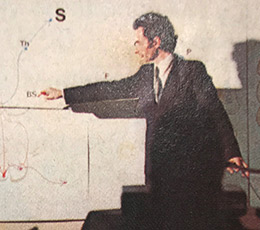
EEG researcher Dr. Jean-Paul Banquet
On a tour of England with Maharishi in 1973, Jean-Paul and I visited Dr. Peter Fenwick, a neuropsychiatrist, in his EEG lab at the Maudsley Hospital in London. Dr. Fenwick said that what happens during TM is the same as what you see during sleep onset, nothing new. “No,” Jean-Paul replied, he could see the difference between the EEG of TM and sleep onset.
Dr. Fenwick then challenged Jean-Paul by showing us two EEG records, which looked quite similar to me, and demanded that he tell us which was TM. Jean-Paul looked thoughtfully at the EEG records for a long 30 seconds, then pointed to one of the records and said, “That one is TM.” He was right! I was relieved. Dr. Fenwick looked skeptical. Lucky guess, I thought to myself, but I knew that Jean-Paul had a deeper understanding of EEG and TM than I did.
It was encounters such as these with Dr. Fenwick that made us feel an urgent need for a more refined EEG measure than synchrony to irrefutably show the uniqueness of Transcendental Consciousness. Jean-Paul identified EEG synchrony by visual inspection of the EEG paper records. Now we needed something more precise. Enter Dr. Paul Levine.
The Discovery That EEG Coherence Increases During TM
Our colleague Paul, being a physicist, began to explore how to adapt a precise measure of synchrony called coherence to the EEG from two regions of the brain, creating the Coherence Spectral Arrays, or COSPARs for short.

Dr. Paul Levine, physicist and creator of the Coherence Spectral Arrays (COSPARS)
Paul was a pioneer in applying computers to calculate the degree of similarity between two waves over time. Synchrony was observed by visual inspection of how the EEG waves rose and fell together, how their peaks and troughs were aligned. Synchrony of waves was relatively easy to see since the two waves looked and remained identical in shape over a few seconds. But EEG varies a lot, and computers were need to estimate the degree of correlation if the waves were not exactly the same but nonetheless exhibited a stable relationship over a few seconds.
This exact quantity is called coherence: the correlation between two areas of the brain compared for a given frequency across time. Coherence was an exact value, ranging from 0 (no coherence) to 1.0 (perfect coherence). Coherence is therefore an accurate measure of the degree of orderliness of interaction between brain regions, and hence how brain diversity is unified moment by moment to support the quality of our thinking.
Paul’s work allowed us, and scientific research in general, to remove subjective judgement, and to detect and explore more subtle changes in global brain dynamics. With this elegant tool, we were in a position to study the process of transcending itself.
Paul’s work at the MERU EEG lab, with the assistance of Russell Hebert, Chris Haynes, Urs Strobel, and Alarik Arenander, laid the foundation for measuring brain orderliness during the experience of transcending, and greatly expanded our knowledge of Transcendental Consciousness.16 His COSPARs showed that the alpha1 EEG brain waves, which Keith had first shown to increase during TM and which Jean-Paul had shown to be synchronous, were highly coherent across the brain. The COSPARS showed that during TM the brain waves from different areas of the brain reached coherence and sustained that coherence at over 95 percent, where perfect coherence is 100 percent (see Chart 1).
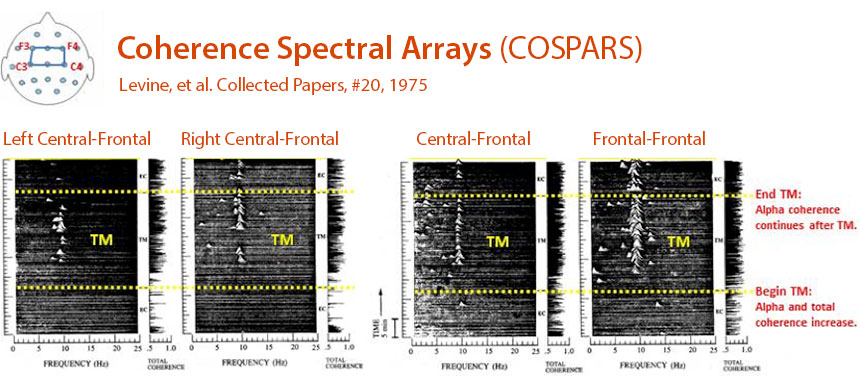
Chart 1. Coherence Spectral Array during TM. This set of four COSPARs shows what is happening in four main brain areas before, during, and after TM practice. The subject had been practicing TM for about 4 years. The dotted yellow lines mark the beginning and end of TM practice. The “mountain peaks” are periods of brain orderliness or coherence over .95 (1.0 is perfect) in the alpha1 8–10 Hz frequency band, which appeared a few minutes after starting TM and continued into the eyes-closed periods after TM. Total coherence (see the right side of each COSPAR) is coherence across all EEG frequency bands, which increased during TM and lasted afterwards.
A night’s sleep, on the other hand, was shown to have the opposite effect, dramatically decreasing alpha1 and total EEG coherence. This told us that the COSPARS provided a window into a person’s state of consciousness, providing further support for Dr. Wallace’s assertion that it was a distinct fourth state of consciousness. The COSPARS showed that, in contrast to sleep, TM was like “falling awake,” effortlessly sliding into a higher level of inner awareness and brain integration.
Paul, by nature a conservative guy, was reluctant to tell Maharishi about these results until he had done more experiments to make sure they were rock solid. But the excitement around the lab grew, and Paul kept asking Alarik, “Should I tell Maharishi?” Finally Paul did, and Maharishi was so delighted, he immediately ordered a boat ride celebration on Lake Lucerne, where Paul announced his discovery to everyone. This was another electric moment in the scientific pursuit of enlightenment.
Clear Transcending, EEG Coherence, Creativity, and H-Reflex Are Interconnected
In 1976, while I was Director of Research at MERU, we were conducting a study contrasting subjects with clear experiences of Transcendental Consciousness with subjects who were having less clear experiences. Here are some examples of clear experiences that we published in 1981 with our study in the International Journal of Neuroscience.22
“The predominant experience in meditation was a deep, expansive silence, stable and immovable in its character.” —Canada
“Most of my meditations have been deep, silent wholeness, with long periods of no breath.” —South Africa
“The experience was very blissful, super clear—it was infinite correlation, because I found that I was infinite, unbounded, existing everywhere the same.” —United States
“I feel this freshness of deep well-being in my whole body… In that state of deep freshness, in the transcendent, attention acquires a more and more important potential of wakefulness.” —France
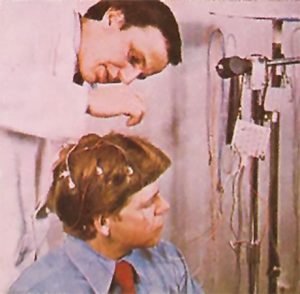
Russell Hebert applies EEG leads to Alarik Arenander, then a UCLA graduate student in neuroanatomy, who was our go-to guy for questions about the brain.
We also had our EEG subjects take standard creativity tests (the Torrance Tests of Creative Thinking), and measured them on the H-reflex, an index of the ability of spinal nerves to rebound quickly after being activated.
One day when I was feeling especially clear and blissful, I asked Russell to have the lab check if there was a correlation between EEG coherence and creativity. From the silence of my awareness, I intuited visually what the correlation would be. I saw numbers slowly rolling up then down until, like a ball in a roulette wheel, when it came to rest on a single number. “The correlation will be about r = 0.71,” I said to Russell. (The r-value ranges from 0 to 1.0, with a higher number indicating a stronger correlation.)
The next day, Russell called and said, “It was 0.71!”18, 22 We were both astonished. We had shown for the first time in history that EEG alpha coherence was associated with creativity, and I had the joy of having intuited its particular correlation.
Maharishi Creates the Optimizing Brain Functioning Chart
One day I was explaining to Maharishi all the different inter-correlations between variables that we’d found. He started drawing on his pad, and I wondered if he was only half listening. But then he handed me his sketch, which was an arrangement of several ovals representing the variables and lines connecting them with the correlations written on them. This chart (see Chart 2) became standard in TM introductory talks throughout the world, and a version of it appears today in the most recent TM research booklets.
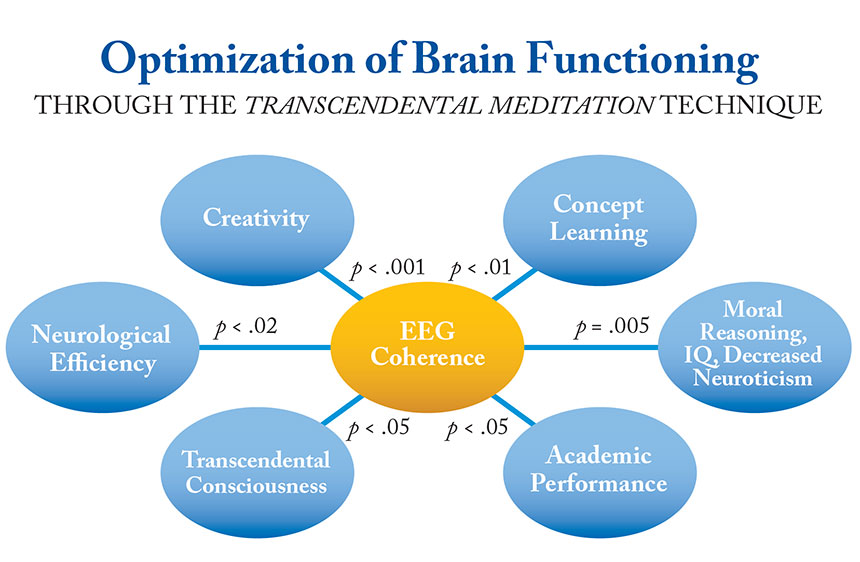
Chart 2. Optimization of Brain Functioning: Correlates of EEG coherence22 (Note: The p-value is the probability that the observed relationship occurred by chance; the smaller the p-value, the stronger the association.)
Chart 2 illustrates how all these different measures are inter-correlated—coherent brain functioning, creativity or “ideational fluency,” increased efficiency in learning new concepts, more principled moral reasoning, higher verbal IQ, decreased neuroticism, higher academic achievement, neurophysiological resilience, and the sublime experience of Transcendental Consciousness (TC). Such interconnectedness indicates that they are different aspects of one integrated system.
Maharishi’s insight that EEG synchrony and coherence are of fundamental importance to brain physiology and the evolution of consciousness is verified by this array of benefits associated with EEG coherence. Paul Levine’s COSPARs had shown that TM increases EEG coherence. This chart shows what increased EEG coherence through TM means in the practical terms of leading a more creative, intelligent, moral life.
Although coherent brain activity was not yet appreciated by modern neurophysiology in the 1970s, today it is recognized as the dynamic foundation of organizing the diversity of brain computation.6, 7 Russell recently told me that when he spoke with Professor Paul Sauseng of the University of Salzburg, a leading authority on EEG synchrony and coherence,6 Professor Sauseng commented that the field of EEG coherence was playing right into the hands of the TM researchers! He was acknowledging that the field had now evolved to recognize the importance of synchrony, as Maharishi had foreseen and focused us on decades before.
Discovering a Bio-Marker for Periods of Transcendental Consciousness
We knew from our own experience that TM practice is typically a mix of several states—some thoughts, some transcending, maybe some drowsiness or sleep, depending on the condition of the body at the time. In our pursuit of the scientifically elusive Transcendental Consciousness, we wanted to identify the exact moment that thoughts did their disappearing act into unbounded awareness. We thought that this would help us pin down that Transcendental Consciousness really was a fourth major state of consciousness. As before, it was Maharishi who oriented us where to look.

Arosa, Switzerland, one of the many beautiful towns in the region where MERU was based and Maharishi was conducting advanced training courses in the 1970s
Many VIPs visited Maharishi at MERU, which at this time was located high in the French Alps at the Annapurna Hotel in Courchevel, an off-season ski resort. This was the headquarters from where Maharishi was conducting advanced TM courses in towns around the region, frequently visiting them by helicopter.
On one such occasion Maharishi took the visitors and an entourage of us scientists to see the EEG lab where an experiment was in progress. Our seven-foot tall EEG machine and other equipment were crammed into one room of a double suite, with the subject meditating in the other room. The group watched as tracings of 12 channels of EEG and one of respiration flowed out in large sheets, folding into a neat stack.
As Alarik explained what was going on, Maharishi asked, “What is that?” waving his hand toward the paper tracings. Alarik, puzzled, stopped his commentary, then started again. After a few moments of watching the tracings, Maharishi again asked, “What is that?” This happened a couple more times, with all of us still befuddled about what Maharishi was referring to.
Then Maharishi stepped forward and started unfurling the neat stack of tracings and spreading them around. “Here, and here, and here,” Maharishi said, pointing to long periods of suspended respiration. “These are periods of Transcendental Consciousness.”
Just as Maharishi had oriented the scientists to study synchrony and coherence as key EEG indicators, now he was orienting us where to look for isolated periods of TC. The subject meditating in the other room, whose advanced practice and unbounded awareness had made this discovery possible, was Sally Peden, one of the leading organizers on Maharishi’s international staff.
Studying Isolated Periods of Transcending
Once Maharishi had pointed this out, it was completely obvious to all of us that respiratory suspension marked isolated periods of clear transcending. We knew this from our own twice-daily meditation practice. But how could we convey this to the world? A skeptic might ask, “How do you know that a subject was transcending when his or her breath became suspended?” Good question.

Chart 3. Respiratory Suspension during Transcendental Consciousness (TC). The button signals mark the periods of pure TC experience, which were found to coincide exactly with suspension of the breath, establishing respiratory suspension as a bio-marker of TC.17
Dr. John T. Farrow, a biochemist trained at Brandeis University, and Russell Hebert came up with a clever series of experiments to show just this. They had subjects press a button after they had a subjective experience of transcending. Sure enough, periods of respiratory suspension preceded each button signal (see Chart 3). This established that a clear experience of Transcendental Consciousness had occurred at that time.
In four different experiments, with 565 criterion-meeting episodes of breath suspension observed in 40 subjects practicing TM, John and Russell established that the moments of TC are associated with breath suspension. Respiratory suspension was now a clear “bio-marker” for Transcendental Consciousness. The suspensions of breath during the TM technique occur spontaneously and naturally as part of a very comfortable experience of deep rest, and there is no shortage of oxygen during this time or of compensatory breathing afterwards.
Global Brain Coherence in the Fourth State of Consciousness
Now that we had a clear bio-marker of the period of Transcendental Consciousness, the next step was to investigate, did anything special happen in the EEG during transcending? Dr. Kheireddine Badawi, a Lebanese physicist visiting from Paris, and Dr. Anne-Marie Rouzere conducted this study in collaboration with Keith Wallace and me.
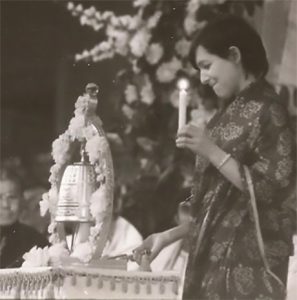
Dr. Anne-Marie Rouzere at a celebration at MERU in the Grand Hall, Seelisberg, Switzerland, c. 1978
We found that during periods of TC, as indicated by respiratory suspension, EEG coherence increases among all brain areas in all frequency bands. This was global coherence, indicating the whole brain was in its simplest, most highly coherent “ground state,” to borrow a term from quantum physics. (See Chart 4.)
Anne-Marie Rouzere did much of the EEG lab work on this study showing increased global EEG coherence during respiratory suspension. Later she also discovered, with Dr. Renata Hartman and Dr. Badawi, that TM produces a unique burst of highly synchronized alpha and theta EEG in the central and frontal brain regions, an enhancement of normally existing rhythms. This further supports the hypothesis that TM produces a unique but natural state of restful alertness.23 More recent research has found that increased alpha amplitude is also associated with elevated mood, which is the common experience during TM.24
A Scientific Portrait of Transcendental Consciousness
So what have we learned? Is there a fourth major state of consciousness, Transcendental Consciousness (TC), as Keith proposed in his doctoral dissertation at UCLA back in 1970 and published in numerous journals?1–3, 25, 26 The short answer is Yes. Keith found that the pattern of physiological changes during the entire period of TM was different from waking, dreaming, and sleep. Of particular interest was increased alpha1 EEG, which indicates a mind-body state of restful alertness.
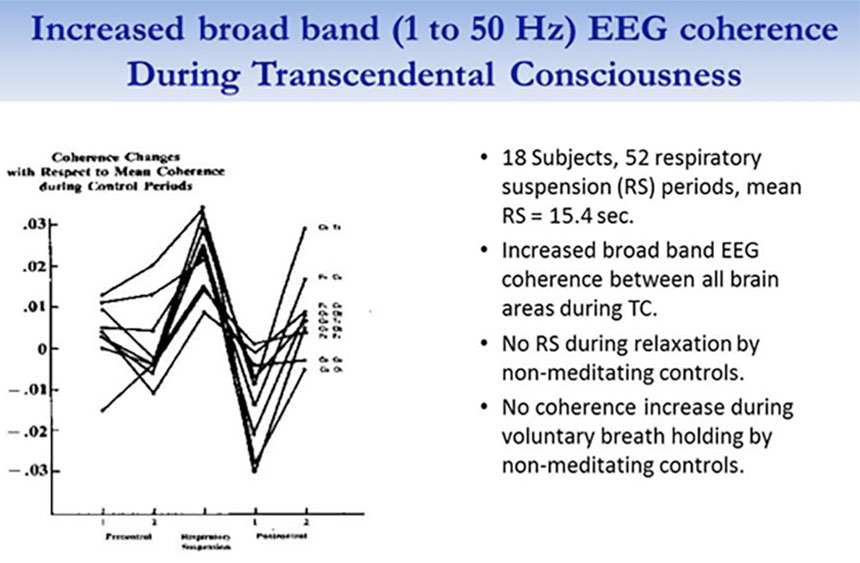
Chart 4. Increased Global EEG Coherence in All Brain Areas during Transcendental Consciousness (TC)27
Subsequent research found that the alpha1 frequency during TM is coherent between all brain areas, which is correlated with a vast array of brain diversity underlying thought, behavior, and feelings—creativity, intelligence, moral reasoning, and lower anxiety.
All the research until this point was on the average changes that occur during the entire period of TM practice, which is usually a mixture of several states. What about specific periods of unbounded awareness during TM practice?
Our studies on the exact moment of the pure experience of Transcendental Consciousness showed that breathing all but stops spontaneously, while the EEG becomes highly coherent across the brain and across all EEG frequencies, which is referred to as global brain coherence. This tells us that moments of pure Transcendental Consciousness are just more integrated versions of what is happening during TM practice generally.
This means that all of us are experiencing Transcendental Consciousness with each meditation, whether or not we are having subjectively clear or even sublime experiences of it!
Furthermore, the research was laying the foundation to show that all of us are developing enlightenment. We had proved the reality of Transcendental Consciousness as a unique fourth state of consciousness. Our further research would prove that with regular TM practice TC becomes stabilized throughout waking, dreaming, and sleeping. This gives rise to a fifth unique state of consciousness: Cosmic Consciousness. Maharishi describes this fifth state and its physiological condition as the basis for success in any walk of life.
Stay Tuned . . .
Part 4 of this series will unfold the exciting story of the research establishing the objective, scientific verification of enlightenment in Cosmic Consciousness. Stay tuned . . .
Read part 1, “A Scientist’s Quest for Enlightenment” ►
Read part 2, “The Remarkable Story of the Scientific Exploration of Enlightenment” ►
For more about Dr. Orme-Johnson’s work, visit his website, www.TruthAboutTM.org ►
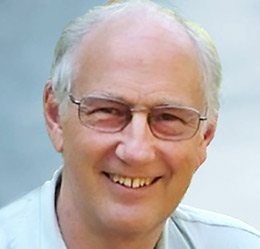
Dr. David Orme-Johnson is one of the principal researchers on the Transcendental Meditation technique worldwide, with over 100 publications in peer-reviewed journals. He served as Director of Research of the International Center for Scientific Research, and Vice Chancellor of Maharishi European Research University. At Maharishi University of Management, Dr. Orme-Johnson was Head of the Psychology Department, Director of the Doctoral Program in Psychology, Co-Director of the Ph.D. program in the Physiology of Human Consciousness, and Dean of Research.
References
1. Wallace RK. Physiological effects of Transcendental Meditation. Science. 1970;167:1751–4.
2. Wallace RK. The Physiology of Meditation. Scientific American. 1972;226:84-90.
3. Wallace RK, Benson H, Wilson AF. A wakeful hypometabolic physiologic state. American Journal of Physiology. 1971;221:795-9.
4. Kanellakos DP, Lukas JS. The psychobiology of Transcendental Meditation: a literature review. Menlo Park, CA: W. A. Benjamin.; 1974.
5. Banquet JP. Spectral analysis of EEG in meditation. Electroencephalography and Clinical Neurophysiology. 1973;35:143-51.
6. Sauseng P, Klimesch W. What does phase information of oscillatory brain activity tell us about cognitive processes? Neuroscience & Biobehavioral Reviews. 2008;32(5):1001-13.
7. Palva S, Palva JM. New vistas for α-frequency band oscillations. Trends in Neurosciences. 2007;30(4):150-8.
8. Eppley K, Abrams AI, Shear J. Differential effects of relaxation techniques on trait anxiety: A meta-analysis. Journal of Clinical Psychology. 1989;45(6):957-74.
9. Orme-Johnson DW, Barnes VA. Effects of the Transcendental Meditation technique on trait anxiety: A meta-analysis of randomized controlled trials. Journal of Alternative and Complementary Medicine. 2013;20(5):330-41.
10. Alexander CN, Robinson P, Rainforth MV. Treating alcohol, nicotine and drug abuse through Transcendental Meditation: A review and statistical meta-analysis. Alcohol Treatment Quarterly. 1994;11:13-87.
11. Anderson JW, Liu CH, Kryscio RJ. Blood pressure response to Transcendental Meditation: A meta-analysis. American Journal of Hypertension. 2008;21(3):310-6.
12. Rainforth MV, Schneider RH, Nidich SI, Gaylord-King C, Salerno JW, Anderson JW. Stress reduction programs in patients with elevated blood pressure: A systematic review and meta-analysis. Current Hypertension Report. 2007;9(6):520-8.
13. Alexander CN, Rainforth MV, Gelderloos P. Transcendental Meditation, Self-Actualization and Psychological Health: A Conceptual Overview and Statistical Meta-Analysis. Journal of Social Behavior and Personality. 1991;6(5):189-247.
14. Travis F. An empirical test of Maharishi’s junction point model. Modern Science and Vedic Science. 1990;4(1):43-55.
15. Travis F. The junction point model: A field model of waking, sleeping, and dreaming, relating dream witnessing, the waking/sleeping transition, and Transcendental Meditation in terms of a common psychophysiologic state. Dreaming. 1994;4(2):91-104.
16. Levine PH, Hebert R, Haynes CT, Strobel U. EEG coherence during the Transcendental Meditation Technique. In: Orme-Johnson D, Farrow, J., editor. Scientific Research on the Transcendental Meditation Program: Collected Papers. Livingston Mannor NY: Maharishi European Research University Press; 1977. p. 187-207.
17. Farrow JT, Hebert JR. Breath suspension during the Transcendental Meditation technique. Psychosomatic Medicine. 1982;44(2):133-53.
18. Haynes CT, Hebert R, Reber W, Orme-Johnson DW. The psychophysiology of advanced participants in the Transcendental Meditation program: Correlations of EEG coherence, creativity, H-reflex recovery, and experiences of Transcendental Consciousness. In: Orme-Johnson DW, Farrow JT, editors. Scientific Research on the Transcendental Meditation Program: Collected Papers, Vol. 1. Livingston Manor, NY: Maharishi European Research University Press; 1976. p. 208-12.
19. Hebert JR, Lehmann D, Tan G, Travis FT, Arenander A. Enhanced EEG alpha time-domain phase synchrony during Transcendental Meditation: Implications for cortical integration theory. Signal Processing. 2005;85(11):2213-32.
20. Hebert R, Lehmann D. Theta bursts: An EEG pattern in normal subjects practising the Transcendental Meditation technique. Electroencephalography and Clinical Neurophysiology. 1977;42:397–405.
21. Orme-Johnson DW, Kolb D, Hebert JR. An experimental analysis of the effects of the Transcendental Meditation technique on reaction time. In: Orme-Johnson D, Farrow J, editors. Scientific research on the Transcendental Meditation program: Collected papers, Vol. 1. Rheinweiler, Germany: MERU Press; 1973/1977.
22. Orme-Johnson DW, Haynes CT. EEG phase coherence, pure consciousness, creativity and TM-Sidhi experiences. International Journal of Neuroscience. 1981;13:211-7.
23. Rouzere A-M, Badawi K, Hartman R. High amplitude fronto-central alpha and theta activity during the Transcendental Meditation technique. In: Chalmers RA, Clements G, Schenkluhn H, Weinless M, editors. Scientific Research on Maharishi’s Transcendental Meditation and TM-Sidhi Program: Collected Papers, Vol. 3, paper 211. Vlodrop, The Netherlands: Maharishi Vedic University Press; 1979/1989.
24. Petsche H, Kaplan S, von Stein A, Filz O. The possible meaning of the upper and lower alpha frequency ranges for cognitive and creative tasks. International Journal of Psychophysiology. 1997;1-3(77-97).
25. Jevning R, Wallace RK, Biedebach M. The physiology of meditation, a review: A wakeful hypometabolic integrated response. Neuroscience and Biobehavioral Reviews. 1992;16:415-24.
26. Wallace RK. The Neurophysiology of Enlightenment. Fairfield, IA: MIU Press; 1986.
27. Badawi K,Wallace RK, Orme-Johnson DW, Rouzere AM. Electrophysiologic characteristics of respiratory suspension periods occurring during the practice of the Transcendental Meditation program. Psychosomatic Medicine. 1984;46:267-76.

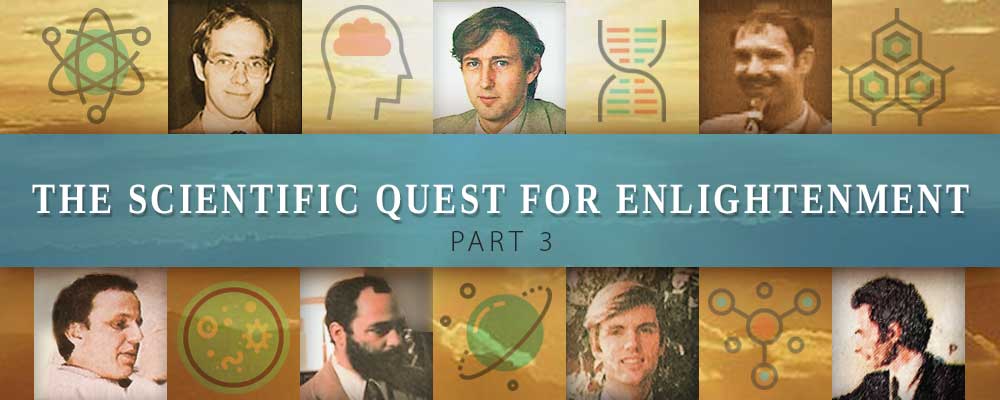

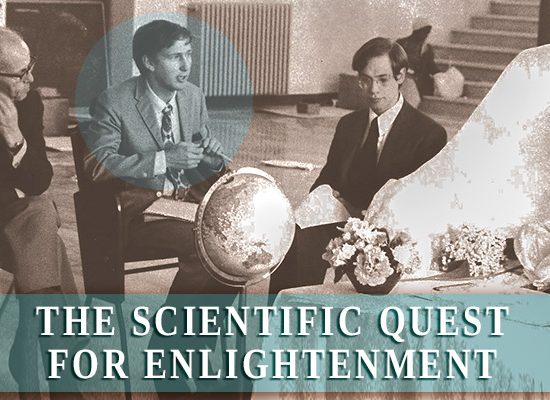

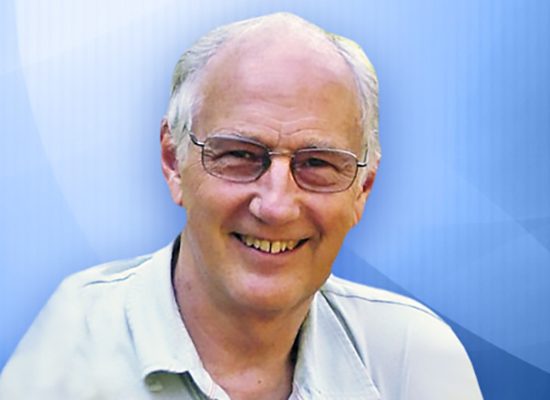
Excellent writing, David. I look forward to when you collect these invaluable articles into a book. Thanks so much, Harbour, for publishing them.
Thank you, Jim. It’s a great pleasure and privilege to work with David, and I so look forward to his book too!
Dear David, Thank you for putting this material together, telling this story, wonderful memories. Warm regards, Paul
Excelente publicación
Muchas gracias Ricardo!
It is an amazing story, thank you for sharing it. I have sent the links to the first three parts to all the meditators on my list. (I am a TM teacher in Hamilton, Ontario.) I would like to read part 4 if it is already available. If you could send me the link to the fourth part I would appreciate it.
Thank you for your comment, Yotka! and for sharing this series with the meditators in your community. Part 4 of Dr. Orme-Johnson’s Scientific Quest for Enlightenment is still in the works and hasn’t been published yet. But it should be coming out in a few months. Stay tuned for more to come!
Is Part 4 already available? My attempt to find it is still unsuccessful… In the meantime, I am re-reading the first three parts — and it again and again feels so amazing. We are so lucky to live in these exciting times when (finally!) science and spirituality are coming together! Being a scientist myself, I love seeing the world becoming better and better! THANK YOU!
Thank you for your wonderful comment, Yotka! We’re delighted to hear how much you’re enjoying Dr. Orme-Johnson’s inspiring series on the scientific quest for enlightenment. We haven’t published Part 4 yet, but plan to do so in the coming months. In the meantime, watch for another article by Dr. Orme-Johnson, on the evidence- and brain-based approach to helping create world peace. You’re also welcome to visit his website for more of his research and writing, at http://www.truthabouttm.org.
Dear David, thank you so much for sharing this enlightening research break through in the knowledge history of mankind in such a clear, factual, “objective”, and at the same time lively, exciting, “subjective” way! Doesn’t this story demonstrate brilliantly how a discovery is a product of the interaction between the researcher and the field being investigated, or, to say it more figuratively, the passionate, yet tender marriage (Devata) of the knower (Rishi) and the known (Chhandas)? Isn’t that what science really is?
Thank you for this memory, Raj. It was such a pleasure to write about people with such great hearts and intellects as Paul.
What a treat to read this article! Paul Levine was a close family friend and mentor (“Uncle Paul” to me), who got me to start TM as a young man 20 years ago. He truly was a special man. Thank you for sharing this.
This is terrific stuff from over 40 years ago. How
has the pace and depth of research picked up
since then?
Stay tuned for Cosmic Consciousness!
Such a lucid explanation of this groundbreaking research. Thank you Dr. Orme-Johnson!
Since I started my TM practice I have been aware of my suspension of breath to the point that I feel that I am not even breathing. This article helped me understand what is happening. Thank you